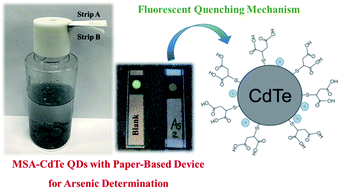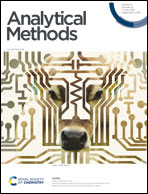A simple paper-based approach for arsenic determination in water using hydride generation coupled with mercaptosuccinic-acid capped CdTe quantum dots†
Abstract
This research aims to develop a simple paper-based device for arsenic detection in water samples where a hydride generation technique coupled with mercaptosuccinic acid-capped CdTe quantum dots (MSA-CdTe QDs) as a detection probe was applied to the detection system. MSA-CdTe QDs were coated on a paper strip, inserted into the cover cap of a reaction bottle, to react with the developed arsine gas. Fluorescent emission of the QDs was quenched upon the presence of arsenic in solutions, whereby only a small amount of the MSA-CdTe QDs was required. The excitation and emission wavelengths for fluorescent detection were 278.5 nm and 548.5 nm, respectively. The proposed system provided a limit of detection of 0.016 mg L−1 and a limit of quantitation of 0.053 mg L−1, and a detection range of 0.05–30.00 mg L−1. In addition, the tolerance level of the detection approach to interference by other vapor-generated species was successfully improved by placing another paper strip coated with a solution of saturated lead acetate in front of the detection paper strip. This developed approach offered a simple and fast, yet accurate and selective detection of arsenic contaminated in water samples. In addition, the mechanism of fluorescent quenching was also proposed.



 Please wait while we load your content...
Please wait while we load your content...